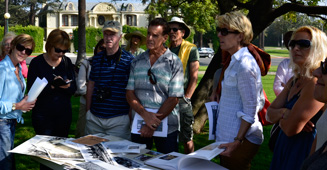

Contributor
- Topics: Archive

Landscape architect Ralph Cornell’s diverse built legacy in Los Angeles will be the focus of What’s Out There Weekend Los Angeles, November 8-9, 2014. Organized by The Cultural Landscape Foundation (TCLF), in partnership with the California Garden and Landscape History Society, the Weekend features free, expert-led tours of more than a dozen significant Cornell projects—this is the first time a Weekend has been devoted to a single practitioner’s work.
Cornell (1890-1972) graduated from Pomona College in 1914 and earned his Master of Landscape Architecture degree three years later from the Harvard School of Design. In 1919 he opened one of the first landscape architecture practices in Los Angeles and would spend his career promoting the preservation of California’s native landscape exhibited through indigenous planting and design restraint. Cornell’s early work included the “campus in a garden” at Pomona College, the 23-block linear park Beverly Gardens, and the 1930s restoration of the landscape at the National Historic Landmark-listed Rancho Los Cerritos. His master plan for the UCLA campus united disparate buildings along a central axis and opened vistas in distinct park settings. In 1955 Cornell became senior partner in collaboration with Samuel Bridgers and Howard Troller and the firm worked extensively on municipal projects throughout Los Angeles including the Civic Center Mall and the Music Center. Cornell’s portfolio would eventually include city parks, subdivisions, luxury hotels, college campus master plans, and parkways. In addition to a prolific design career, Cornell promoted conservation and wrote extensively about landscape architecture.
Since 2010 TCLF’s What’s Out There Weekend program has brought national focus to the landscape architecture legacies of Chicago, Miami, New York, San Francisco, Washington, DC and numerous other locations. The first What’s Out There Weekend Los Angeles in October 2013 was so popular—more than 1,000 people attended—it prompted calls for an immediate follow-up. Because of Cornell’s significant design impact, much of which could not be included in the October 2013 event, it was decided his legacy would be the focus. The tours will reveal Cornell’s life, career, and impact on Southern California and the field of landscape architecture.









Responses